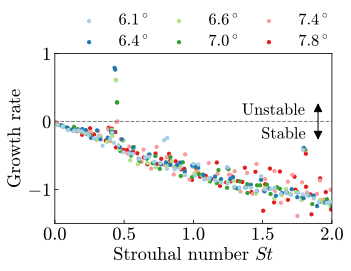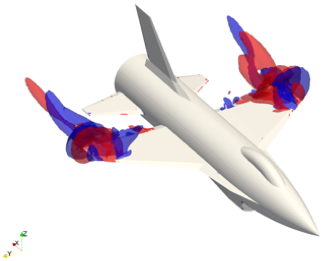Research of numerical prediction for the flight stability
JAXA Supercomputer System Annual Report February 2024-January 2025
Report Number: R24EDA201G26
Subject Category: Aeronautical Technology
- Responsible Representative: Kazuyuki Nakakita, Aeronarutical Technology Directorate, Fundamental research unit
- Contact Information: Yoimi Kojima(kojima.yoimi@jaxa.jp)
- Members: Hirokazu Higashida, Atsushi Hashimoto, Junpei Kakazu, Yoimi Kojima, Hideji Saiki
Abstract
The flight stability of aircraft is necessary to establish safe flight. We aim to improve the technology level of flight stability prediction through numerical simulation. The numerical method is validated and analyzed for developing better numerical tools.
Reference URL
N/A
Reasons and benefits of using JAXA Supercomputer System
Unsteady simulations required for the stability analysis demand large computational resources and produce much data. JSS allows us to simulate and analysis of numerical results.
Achievements of the Year
To enable rapid prediction of roll instability, a prediction technique based on Global Stability Analysis (GSA) was developed. Using FaSTAR-GSA, a fast analysis tool, flow instabilities were predicted. Analysis of the eigenvalue distribution obtained from GSA (Fig. 1) revealed that under flow conditions where roll instability occurs in experiments, unstable eigenvalues corresponding to the flow field were identified. GSA successfully predicted the flow conditions under which roll instability arises. Furthermore, visualization of the unstable mode (Fig. 2) showed that the flow instability originates near the wingtip of the main wing.
Publications
- Oral Presentations
Kojima, Hidaka, Nagai, On the transonic roll instability of SDM model, 56th FDC/42nd ANSS, 2D04, 2024.
Usage of JSS
Computational Information
- Process Parallelization Methods: MPI
- Thread Parallelization Methods: N/A
- Number of Processes: 1152 - 3456
- Elapsed Time per Case: 300 Hour(s)
JSS3 Resources Used
Fraction of Usage in Total Resources*1(%): 0.98
Details
Please refer to System Configuration of JSS3 for the system configuration and major specifications of JSS3.
| System Name | CPU Resources Used(Core x Hours) | Fraction of Usage*2(%) |
|---|---|---|
| TOKI-SORA | 26315953.43 | 1.20 |
| TOKI-ST | 29597.34 | 0.03 |
| TOKI-GP | 0.00 | 0.00 |
| TOKI-XM | 10.08 | 0.00 |
| TOKI-LM | 10174.22 | 0.73 |
| TOKI-TST | 0.00 | 0.00 |
| TOKI-TGP | 0.00 | 0.00 |
| TOKI-TLM | 0.00 | 0.00 |
| File System Name | Storage Assigned(GiB) | Fraction of Usage*2(%) |
|---|---|---|
| /home | 33.38 | 0.02 |
| /data and /data2 | 48157.17 | 0.23 |
| /ssd | 239.05 | 0.01 |
| Archiver Name | Storage Used(TiB) | Fraction of Usage*2(%) |
|---|---|---|
| J-SPACE | 17.59 | 0.06 |
*1: Fraction of Usage in Total Resources: Weighted average of three resource types (Computing, File System, and Archiver).
*2: Fraction of Usage:Percentage of usage relative to each resource used in one year.
ISV Software Licenses Used
| ISV Software Licenses Used(Hours) | Fraction of Usage*2(%) | |
|---|---|---|
| ISV Software Licenses(Total) | 457.15 | 0.31 |
*2: Fraction of Usage:Percentage of usage relative to each resource used in one year.
JAXA Supercomputer System Annual Report February 2024-January 2025




